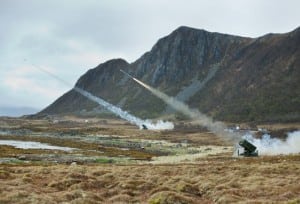The Pentagon on Tuesday confirmed the first two National Advanced Surface-to-Air Missile Systems (NASAMS) have been delivered to Ukraine and are operational.
“These systems will contribute to Ukraine’s air defense capabilities and will help protect the Ukrainian people against Russian aerial attacks, to include those conducted by unmanned aerial vehicles or cruise missiles,” Air Force Brig Gen. Pat Ryder, the Pentagon press secretary, told reporters during a briefing.

Photo: Raytheon
Oleksii Reznikov, Ukraine’s minister of defense, first announced on Monday that the NASAMS had arrived along with Aspide air defense systems from Spain.
“Look who’s here! NASAMS and Aspide air defense systems arrived in Ukraine! These weapons will significantly strengthen [the Ukrainian Army] and will make our skies safer. We will continue to shoot down the enemy targets attacking us. Thank you to our partners: Norway, Spain and the U.S.,” Reznikov wrote in a social media post.
The NASAMS air defense system is jointly developed by Raytheon Technologies [RTX] and Norway’s Kongsberg, and brings together Raytheon’s Sentinel radar and Advanced Medium Range Air-to-Air Missiles (AMRAAM) with Kongsberg’s Fire Distribution Center.
The two NASAMS were included as part of an $820 million security assistance package the U.S. approved in early July, with the systems to be procured with Ukraine Security Assistance Initiative (USAI) funds (Defense Daily, July 1).
In late August, Raytheon was awarded a $182.3 million contract to supply the two NASAMS units for Ukraine (Defense Daily, Aug. 29).
“Raytheon Missiles & Defense and our partners are working diligently to quickly deliver this critical, proven air defense capability to help the Ukrainian people defend their homeland,” Tom LaLiberty, president of Raytheon Missile & Defense’s land warfare and air defense business area, said in a statement at the time. “Ukraine will join a dozen nations around the globe who rely on NASAMS to defeat a multitude of threats, including cruise missiles, aircraft, and unmanned systems.”
Ryder said the AMRAAM missiles for the NASAMS are supplied “from a variety of sources, to include U.S. stocks and those of various allies and partners,” while he declined to offer specifics on how Ukraine may employ the systems and the kinds of ranges the weapons can reach on the battlefield.
“I don’t want to get into those details for operations security reasons. I will say, though, that it does provide a significant air defense capability in the sense that it can protect against, as I mentioned, UAV attacks, both armed and unarmed. It can defend against helicopters, cruise missiles as well as crewed aircraft,” Ryder said. “Any air defense system is going to be complex by its very nature because you’re integrating a lot of different aspects, to include the ability to detect, the ability to respond. And so that is an area that we’ll continue to work with and consult with the Ukrainians on…how to best integrate that as they convert using some Soviet era, Soviet-type build equipment with, as you point out, with Western modern NATO systems.”
Ukrainian President Volodymyr Zelenskyy in late October reiterated his country’s request for air defense capabilities to assist in its fight against Russia’s ongoing invasion, to include calling the Patriot missile defense system an “extreme priority” (Defense Daily, Oct. 28).
“If you would say, ‘Yes, we can give you Patriots,’ I would go myself to the U.S. for them. It’s really important for our people,” Zelenskyy said via English translation during a Yale School of Management discussion. “We have to defend our skies. If my memory serves me right, I’ve been saying that since the first days of the war. Aviation and aerial defense, this is what we lack. We need to defend our skies to defend our children. Russia can do nothing against us on land.”
A $3 billion weapons aid package the U.S approved on Aug. 24 included plans to procure six more NASAMS for Ukraine with USAI funds (Defense Daily, Aug. 24).